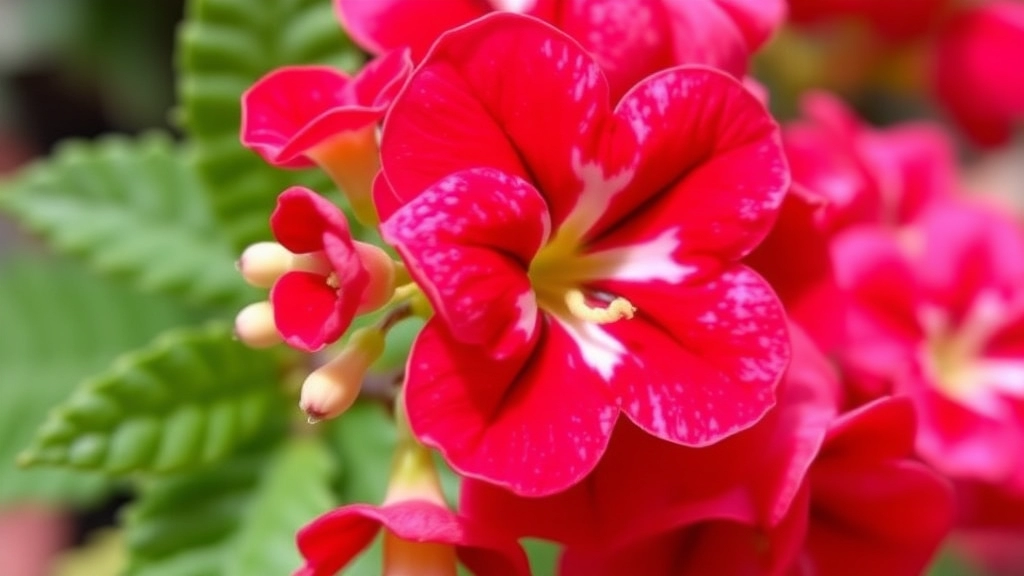Kalanchoe Spider Charlotte
When it comes to unique and captivating succulents, the Kalanchoe Spider Charlotte stands out with its striking appearance and easy-care nature. This beautiful plant features dark green or green-blue leaves that resemble antlers, adding a touch of exotic charm to any garden or indoor space. Its bright pink flowers are a delightful contrast, making it a favourite among succulent enthusiasts and gardeners alike.
Growth Requirements
For those interested in cultivating Kalanchoe Spider Charlotte, understanding its growth requirements is key. This succulent thrives in well-draining soil and prefers bright, indirect light. Watering should be done sparingly, allowing the soil to dry out completely between waterings to prevent root rot. Additionally, it’s crucial to be aware of its toxicity, particularly if you have pets or children, as certain parts of the plant can be harmful if ingested.
Characteristics of Kalanchoe Spider Charlotte
Are you looking for a unique houseplant that adds a touch of charm to your home?
The Kalanchoe Spider Charlotte might just be the perfect choice for you.
This succulent is renowned for its striking features and ease of care, making it a favourite among both novice and experienced gardeners.
Key Characteristics
- Succulent Nature: As a succulent, it stores water in its leaves, making it drought-resistant.
- Growth Habit: The Kalanchoe Spider Charlotte has a distinctive trailing growth pattern, which can make it an eye-catching addition to any space.
- Leaf Structure: Its leaves are fleshy, with a unique serrated edge that adds texture and interest.
- Variegated Foliage: The plant often displays a mix of green and cream colours, enhancing its aesthetic appeal.
This plant is not just about looks; it’s also incredibly resilient, thriving in various conditions. For those interested in other unique varieties, you might want to explore the Top Kalanchoe Mother of Thousands Varieties. Additionally, understanding the Best Practices for Indoor and Outdoor Care can help you maintain a thriving Kalanchoe collection.
Unique Appearance and Leaf Structure
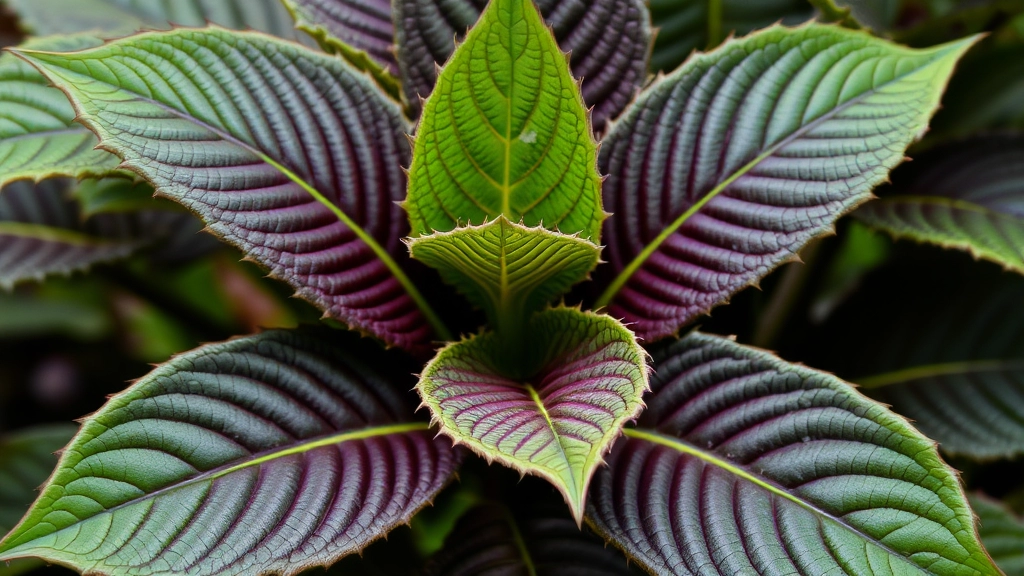
When it comes to the Kalanchoe Spider Charlotte, one of the first things that catches your eye is its unique look. You might be wondering, “What makes this plant stand out?”
Eye-Catching Features
The Kalanchoe Spider Charlotte is truly a showstopper.
- Fleshy Leaves: Its leaves are thick and fleshy, typical of succulents, but they have a distinct shape that resembles a spider’s leg.
- Curled Edges: The edges of the leaves curl slightly, adding to its quirky charm.
- Vibrant Colour: You’ll notice a mix of green and a hint of reddish hue, especially when exposed to bright light.
These features not only make it visually appealing but also serve a purpose in water retention.
Leaf Structure
Let’s dive a bit deeper into the leaf structure.
- Size: The leaves can grow quite large, giving the plant a full, bushy look.
- Texture: They have a smooth surface, which helps reduce water loss.
- Growth Pattern: The leaves grow in a rosette pattern, creating a lovely focal point in any space.
This unique leaf structure is one of the reasons why the Kalanchoe Spider Charlotte is a favourite among plant lovers.
Best Growing Conditions for Kalanchoe Spider Charlotte
When it comes to nurturing your Kalanchoe Spider Charlotte, understanding the ideal growing conditions is crucial. Many plant enthusiasts often worry about the right environment for their plants, and this succulent is no exception.
Optimal Temperature
Kalanchoe Spider Charlotte thrives in moderate temperatures.
- Ideal Range: 20°C to 25°C (68°F to 77°F)
- Avoid: Frost and extreme heat above 30°C (86°F)
Humidity Levels
This succulent prefers a dry atmosphere.
- Best Humidity: 30% to 50%
- Tip: Avoid overly humid spaces, as this can lead to root rot.
Indoor vs. Outdoor
While it can grow both indoors and outdoors, consider the following:
- Indoors: Ensure good airflow and bright light.
- Outdoors: Choose a spot with partial shade, especially in hotter climates.
Soil Composition
Kalanchoe Spider Charlotte requires well-draining soil.
- Recommended Mix: Cactus or succulent potting mix, often containing sand or perlite.
- pH Level: Slightly acidic to neutral (6.0 to 7.0).
Fertilization
Feeding your plant properly can enhance its growth.
Watering and Light Requirements
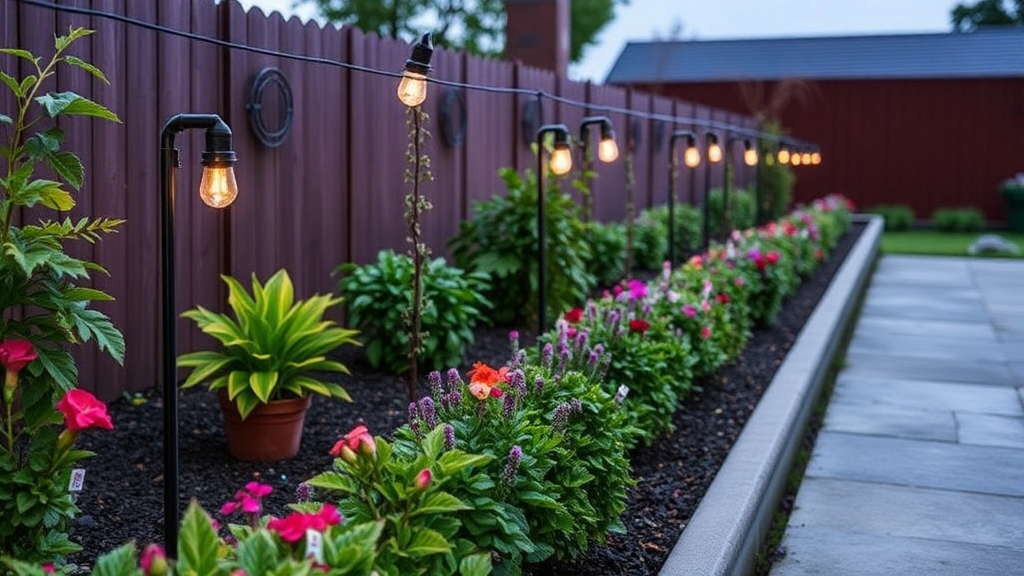
When caring for your Kalanchoe Spider Charlotte, understanding its watering and light needs is crucial to keeping it healthy and vibrant.
Watering Guidelines
One of the most common concerns for plant owners is overwatering. Kalanchoe Spider Charlotte thrives best with a careful watering routine. Here are some key points to consider:
- Frequency: Water your plant every 2-3 weeks during the growing season (spring and summer). In the dormant winter months, reduce watering to once a month.
- Soil Check: Always check the top inch of soil. If it feels dry, it’s time to water. If it’s still moist, hold off.
- Drainage: Ensure your pot has proper drainage holes. This helps prevent root rot, a common issue with overwatered plants.
Light Requirements
Light plays a significant role in the growth and flowering of your Kalanchoe Spider Charlotte. Here’s what you need to know:
- Bright Indirect Light: This plant prefers bright, indirect sunlight. A south-facing window is ideal, but avoid direct sunlight which can scorch the leaves.
- Duration: Aim for 6 hours of light each day. If natural light is limited, consider using a grow light.
- Signs of Improper Light: Yellowing leaves can indicate too much direct sun, while leggy growth suggests insufficient light.
Toxicity Considerations for Pets and Humans
As we delve into the care of Kalanchoe Spider Charlotte, it’s essential to consider its potential toxicity. Many plant enthusiasts often worry about the safety of their beloved pets and family members around houseplants.
Is Kalanchoe Spider Charlotte Toxic?
- Yes, Kalanchoe plants, including the Spider Charlotte variety, are known to be toxic to both pets and humans.
- The plant contains compounds called bufadienolides, which can cause gastrointestinal issues if ingested.
Symptoms of Toxicity
If ingested, you may notice symptoms such as:
- Vomiting
- Diarrhoea
- Lethargy
- Drooling
Precautionary Measures
To keep your home safe:
- Place the plant out of reach of pets and small children.
- Educate family members about the dangers of ingesting this plant.
What to Do If Ingestion Occurs
If you suspect that someone has ingested Kalanchoe Spider Charlotte:
- Contact your local poison control centre immediately.
- Seek veterinary advice for pets.
For more detailed information on the potential risks, you can read our article on Kalanchoe Poisonous to Humans. Additionally, if you have pets, it’s crucial to understand the toxicity risks for cats and take the necessary precautions.
Propagation Techniques: How to Grow New Kalanchoe Spider Charlotte Plants
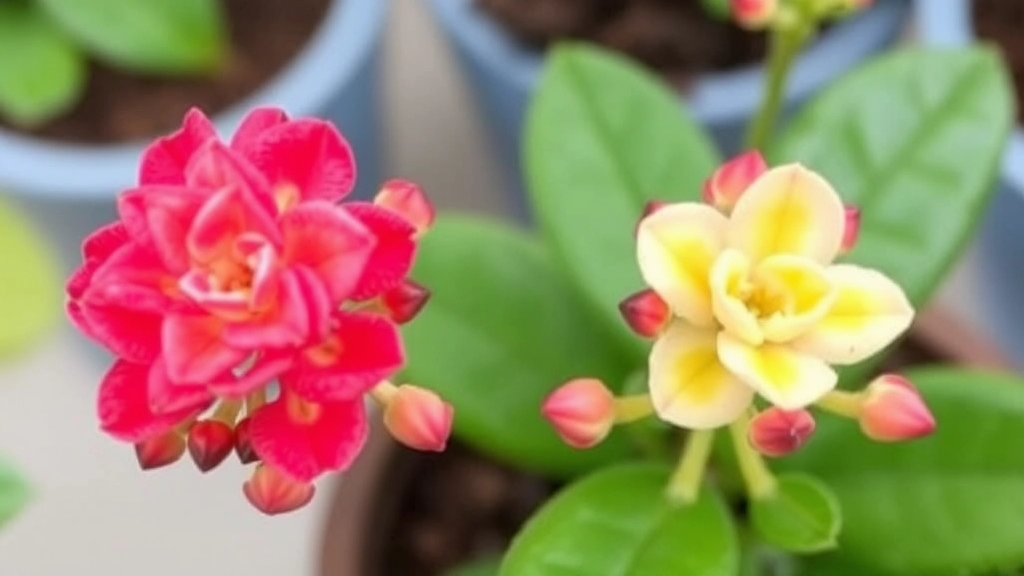
So, you’re keen on expanding your Kalanchoe Spider Charlotte collection? I get it—these beauties are hard to resist!
Why Propagate?
Propagation is a fantastic way to create new plants without spending a penny. Plus, it’s a rewarding experience to watch your little cuttings grow into full-fledged plants.
Propagation Methods
Here are a few easy methods to propagate Kalanchoe Spider Charlotte:
- Leaf Cuttings:
- Choose a healthy leaf from the parent plant.
- Cut it cleanly with sterilised scissors.
- Let it dry for a day or two to form a callus.
- Place it on well-draining soil and mist lightly.
- Keep it in bright, indirect light.
- Offsets:
- Look for small plantlets or offsets around the base of the parent.
- Gently twist them off, making sure to include some roots.
- Plant them in their own pots with suitable soil.
- Water sparingly until they establish themselves.
- Stem Cuttings:
- Cut a healthy stem about 4-6 inches long.
- Remove the lower leaves.
- Allow it to dry for a couple of days.
- Plant it in soil and water lightly.
Tips for Successful Propagation
- Timing: Spring is the best time for propagation when the plant is actively growing.
- Humidity: A little humidity can help. You might want to cover your cuttings with a plastic bag to create a mini greenhouse effect.
- Patience: It can take a few weeks for roots to develop, so don’t rush the process.
Common Pests and How to Deal with Them
As we delve deeper into caring for your Kalanchoe Spider Charlotte, it’s essential to address a significant concern for many plant enthusiasts: pests. These unwelcome visitors can undermine the health of your plant and diminish its beauty.
Common Pests:
- Mealybugs
Appearance: White, cotton-like masses on leaves and stems.
How to Identify: They often cluster in leaf joints. - Spider Mites
Appearance: Tiny, red or yellow specks, often leaving webbing.
How to Identify: Look for fine webs, especially on the undersides of leaves. - Aphids
Appearance: Small, green or black insects.
How to Identify: They tend to congregate on new growth. - Scale Insects
Appearance: Brown, shell-like bumps on stems and leaves.
How to Identify: They can be mistaken for a natural part of the plant.
Dealing with Pests:
- Regular Inspections
Check your plant weekly for signs of pests.
Early detection is key to successful treatment. - Natural Remedies
- Neem Oil: A natural pesticide effective against many pests.
- Insecticidal Soap: Safe for plants and can eliminate soft-bodied insects.
- Physical Removal
Use a cotton swab dipped in alcohol to remove mealybugs.
Rinse the plant with water to dislodge spider mites. - Isolation
If you find pests, isolate the affected plant to prevent spreading. - Maintain Healthy Conditions
Healthy plants are less susceptible to pests.
Ensure proper watering and light conditions to boost plant immunity. For more detailed care tips, check out our Kalanchoe Mother of Thousands Care and Propagation Guide and our guide on Optimal Sunlight for Kalanchoe.
Soil and Potting Recommendations for Kalanchoe Spider Charlotte
So, you’ve got your Kalanchoe Spider Charlotte and you’re wondering about the best soil and potting options? You’re not alone! Getting the right soil mix is crucial for keeping your plant happy and thriving.
Choosing the Right Soil
When it comes to soil, Kalanchoe Spider Charlotte prefers a well-draining mix. Here’s what you should consider:
- Cactus Mix: A cactus or succulent mix is a fantastic choice. It allows excess water to drain quickly, preventing root rot.
- DIY Mix: You can make your own by mixing regular potting soil with perlite or sand. A 2:1 ratio works wonders.
- pH Level: Aim for a slightly acidic to neutral pH (around 6.0 to 7.0). This helps with nutrient absorption.
Potting Tips
Now that you’ve got the soil sorted, let’s talk pots. Picking the right container is just as important:
- Drainage Holes: Always choose a pot with drainage holes. This helps excess water escape.
- Size Matters: Go for a pot that’s slightly bigger than the root ball. Too much space can lead to overwatering.
- Material: Terracotta pots are great for succulents as they allow the soil to breathe.
Repotting
You might be wondering when to repot. Generally, every couple of years is good, especially if you notice roots poking out of the drainage holes.
Best Containers for Optimal Growth
Choosing the right container for your Kalanchoe Spider Charlotte is crucial for its health and growth. Have you ever wondered why some plants thrive while others struggle? The answer often lies in the pot.
Container Size Matters
- Size: Ensure the pot is large enough to accommodate the plant’s growth but not excessively big. A pot that is too large can lead to overwatering issues. A diameter of 10-12 cm is usually ideal for young plants.
- Depth: Kalanchoe has a relatively shallow root system, so a pot that is 15-20 cm deep is generally sufficient.
Drainage is Key
- Drainage Holes: Always opt for pots with drainage holes. This prevents water from pooling at the bottom, which can cause root rot.
- Material: Terracotta or ceramic pots are excellent choices. They allow for better airflow and moisture control compared to plastic.
Consider Aesthetic Appeal
- Design: Choose a container that complements your home décor. A stylish pot can enhance the visual appeal of your Kalanchoe Spider Charlotte, making it a focal point in your space.
- Colour: Lighter colours reflect sunlight and can help regulate soil temperature, while darker pots may absorb heat.
Additional Tips
- Self-Watering Pots: If you often forget to water, consider a self-watering pot. These can provide a consistent moisture level for your plant.
- Repotting: Don’t forget to repot every couple of years to refresh the soil and provide more space for growth. For more detailed tips, check out our guide on Kalanchoe leaf propagation.
For further information on how to care for your Kalanchoe Spider Charlotte, you might find our ultimate guide to fuzzy Kalanchoe care very helpful.
Seasonal Flowering and Maintenance of Kalanchoe Spider Charlotte
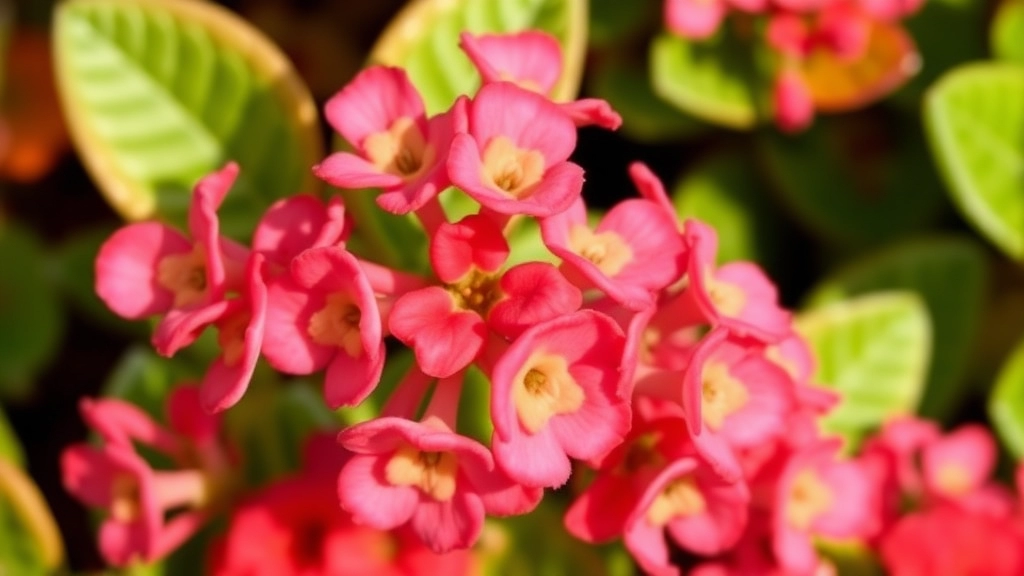
So, you’ve got your Kalanchoe Spider Charlotte thriving, but what about that stunning seasonal flowering?
When Does it Flower?
Kalanchoe Spider Charlotte usually blooms in the late winter to early spring.
- Timing: Expect vibrant flowers from February to April.
- Signs of Flowering: Look for buds forming at the tips of the stems.
How to Encourage Flowering
If you want to coax those beautiful blooms out, here are some simple tips:
- Light: Ensure it gets plenty of bright, indirect sunlight.
- Fertilizer: Use a balanced liquid fertilizer every couple of weeks during the growing season.
- Pruning: After flowering, trim back the spent blooms to encourage new growth.
Maintenance Tips
Keeping your Kalanchoe Spider Charlotte in tip-top shape is a breeze with these maintenance hacks:
- Watering: Water only when the top inch of soil is dry. Overwatering can lead to root rot.
- Temperature: Keep it in a warm spot, ideally between 18-24°C.
- Humidity: Average household humidity is fine, but avoid overly damp areas.
Seasonal Care Adjustments
As the seasons change, so should your care routine:
- Spring/Summer: Increase watering frequency as the plant actively grows.
- Autumn/Winter: Reduce watering and let it rest.
Differences Between Kalanchoe Spider Charlotte and Other Kalanchoe Varieties
When exploring the diverse world of Kalanchoe, many enthusiasts find themselves wondering how Kalanchoe Spider Charlotte stands out among its relatives.
Popular Uses in Home Décor and Gardens
So, you’ve got your Kalanchoe Spider Charlotte, and you’re wondering how to make the most of its unique charm in your home or garden.
This plant isn’t just a pretty face; it’s versatile and can be used in a variety of ways to enhance your space.
Indoor Décor
- Table Centerpieces
- Place your Kalanchoe Spider Charlotte in a stylish pot and use it as a focal point on your dining or coffee table.
- It adds a splash of greenery.
- The vibrant leaves can spark conversation.
- Windowsills
- These plants thrive in bright light, making them perfect for sunny windowsills.
- They create a lively atmosphere.
- Plus, they’re easy to care for and look great in clusters.
- Shelving Units
- Add height and interest by placing your Kalanchoe on a shelf.
- Pair it with books or other decorative items for a curated look.
- The trailing leaves add a touch of whimsy.
Outdoor Gardens
- Rock Gardens
- Kalanchoe Spider Charlotte fits perfectly in a rock garden, adding texture and colour.
- It complements stones and other succulents beautifully.
- Low maintenance is a huge plus!
- Container Gardens
- Use these plants in mixed containers with other succulents or flowers.
- They thrive together and create a stunning display.
- You can easily change arrangements with the seasons.
- Pathway Borders
- Line your garden paths with Kalanchoe Spider Charlotte for a welcoming touch.
- Their unique leaf structure draws the eye.
- They’re hardy and can withstand foot traffic.
Seasonal Displays
Incorporating Kalanchoe Spider Charlotte into seasonal décor can be a fun way to keep things fresh.
- Add festive decorations around them during holidays.
- They can transition from summer to autumn with ease.
FAQs about Kalanchoe Spider Charlotte
What makes the Kalanchoe Spider Charlotte unique?
The Kalanchoe Spider Charlotte stands out due to its fleshy leaves that resemble a spider’s leg, curled edges, and a vibrant mix of green and reddish hues when exposed to bright light.
How should I water my Kalanchoe Spider Charlotte?
Water your plant every 2-3 weeks during the growing season (spring and summer) and reduce to once a month in winter. Always check the top inch of soil; if it’s dry, it’s time to water. Ensure your pot has proper drainage to prevent root rot.
What light conditions does Kalanchoe Spider Charlotte prefer?
This plant thrives in bright, indirect sunlight. Aim for about 6 hours of light each day. Avoid direct sunlight, which can scorch the leaves. Yellowing leaves indicate too much direct sun, while leggy growth suggests insufficient light.
How can I propagate Kalanchoe Spider Charlotte?
You can propagate this plant using leaf cuttings, offsets, or stem cuttings. Each method involves allowing the cuttings to dry before planting them in well-draining soil and providing bright, indirect light.
What type of soil is best for Kalanchoe Spider Charlotte?
A cactus or succulent mix is ideal. You can also create a DIY mix by combining regular potting soil with perlite or sand in a 2:1 ratio. Aim for a slightly acidic to neutral pH (around 6.0 to 7.0).
When should I repot my Kalanchoe Spider Charlotte?
Repot your plant every couple of years or when you notice roots poking out of the drainage holes. Choose a pot with drainage holes and slightly larger than the root ball to avoid overwatering.
When does Kalanchoe Spider Charlotte flower?
This plant typically blooms from late winter to early spring, with vibrant flowers appearing from February to April. Look for buds forming at the tips of the stems as a sign of flowering.
How can I encourage my Kalanchoe Spider Charlotte to flower?
Ensure it gets plenty of bright, indirect sunlight, use a balanced liquid fertilizer every couple of weeks during the growing season, and trim back spent blooms to encourage new growth.
What are some maintenance tips for Kalanchoe Spider Charlotte?
Water only when the top inch of soil is dry, keep the plant in a warm spot (18-24°C), and avoid overly damp areas. Adjust your care routine seasonally by increasing watering in spring/summer and reducing it in autumn/winter.
References
-
The Spruce: Kalanchoe Plant Profile
-
Gardening Know How: Kalanchoe Care
-
The Sill: Kalanchoe Care Guide
